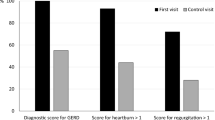Abstract
Objective
To study the effect of nasogastric suction and ranitidine on the determination of gastric intramucosal pH (pHi).
Design
Prospective study.
Setting
Clinical research unit at a university hospital intensive care department.
Subjects
12 healthy volunteers.
Interventions
After a 2-h measurement control period a tonometer was connected to nasogastric suction for 2 h, and thereafter ranitidine was given intravenously and gastric pHi measured.
Measurements and results
During each 2-h measurement period gastric PCO2, gastric pHi, and pH gap were determined every 30 min. Luminal pH was measured after insertion of tonometer and at the end of each study period. Neither nasogastric suction nor ranitidine had an effect on the coefficient of variation for either gastric PCO2 or pHi. Compared to control and nasogastric suction periods, after ranitidine mean gastric pHi was higher (control 7.22±0.08; nasogastric suction 7.23±0.07; after ranitidine 7.31±0.06,p<0.001) mean gastric PCO2 lower (control 6.4±1.3; nasogastric suction 6.5±1.3; after ranitidine 5.3±0.9,p<0.001) and pH gap lower (control 0.18±0.08; nasogastric suction 0.17±0.05; after ranitidine 0.09±0.06,p<0.01). Luminal pH increased after ranitidine in each subject.
Conclusions
H2 blockers have no effect on the reproducibility of gastric pHi measurements, but the use of H2 blockers modifies the normal values for gastric pHi in healthy subjects.
Similar content being viewed by others
References
Grum C, Fiddian-Green R, Pittenger G (1984) Adequacy of tissue oxygenation in the intact dog intestine. J Appl Physiol 56:1065–1069
Riddington D, Balasubramanian Venkatesh K, Clutton-Brock T, Bion J (1994) Measuring carbon dioxide tension in saline and alternative solutions: quantification of bias and precision in two blood gas analyzers. Crit Care Med 22:96–100
Takala J, Parviainen I, Siloaho M, Ruokonen E, Hämäläinen E (1994) Saline PCO2 is an important source of error in the assessment of gastric intramucosal pH. Crit Care Med 22: 1877–1879
Heard SO, Helsmoortel CM, Kent JC, Shahnarian A, Fink MP (1991) Gastric tonometry in healthy volunteers: effect of ranitidine on calculated intramural pH. Crit Care Med 19:271–274
Kolkman J, Groeneveld A, Meuwissen S (1994) Effect of ranitidine on basal and bicarbonate enhanced intragastric PCO2: a tonometric study. Gut 35:737–741
Maynard N, Atkinson S, Mason R, Smithies M, Bihari D (1994) Influence of intravenous ranitidine on gastric intramucosal pH in critically ill patients. Crit Care Med 22:A79
Baigorri F, Calvet X, Duarte M, Saura P, Jubert P, Royo C, Joseph D, Artigas A (1994) Effect of ranitidine treatment in gastric intramucosal pH determinations in critical patients. Intensive Care Med 20:S2
Fiddian-Green RG, Baker S (1987) Predictive value of stomach wall pH for complications after cardiac operations: comparison with other monitoring. Crit Care Med 15:153–156
Gys T, Hubens A, Neels H, Lauwers LF, Peeters R (1988) Prognostic value of gastric intramural pH in surgical intensive care patients. Crit Care Med 16:1222–1224
Doglio GR, Pusajo JF, Egurrola MA, Bonfigli GC, Parra C, Vetere L, Hernandez MS, Fernandez S, Palizas F, Gutierrez G (1991) Gastric mucosal pH as a prognostic index of mortality in critically ill patients. Crit Care Med 19:1037–1040
Maynard N, Bihari D, Beale R, Smithies M, Baldock G, Mason R, McColl I (1993) Assessment of splanchnic oxygenation by gastric tonometry in patients with acute circulatory failure. JAMA 270:1203–1210
Driks MR, Craven DE, Celli BR, Manning M, Burke RA, Gargvin GM, Kunches LM, Farber HW, Wedel SA, McCabe WR (1987) Nosocomial pneumonia in intubated patients given sucralfate as compared with antacids or histamine type 2 blockers: the role of gastric colonization. N Engl J Med 317:1376–1382
Higgins D, Mythen MG, Webb AR (1994) Low intramucosal pH is associated with failure to acidify the gastric lumen in response to pentagastrin. Intensive Care Med 20:105–108
Diebel L, Kozol R, Wilson RF, Mahajan S, Abu-Hamdan D, Thomas D (1993) Gastric intramucosal acidosis in patients with chronic kidney failure. Surgery 113:520–526
Wood PR, Cudworth P, Davies GE, Lawler PG (1992) Potential hazards in estimation of gastric intramucosal pH. Lancet 340:913
Atanassoff PG, Brull SJ, Weiss BM, Landefeld K, Alon E (1995) Time-course of gastric pH changes induced by omeprazole and ranitidine: a 24 hour dose-response study. Anesth Analg 80:S19
Author information
Authors and Affiliations
Additional information
This study was supported, in part, by the senior clinical researcher's grant 1945/3015/92 from the Academy of Finland to Dr. Takala.
Rights and permissions
About this article
Cite this article
Parviainen, I., Vaisänen, O., Ruokonen, E. et al. Effect of nasogastric suction and ranitidine on the calculated gastric intramucosal pH. Intensive Care Med 22, 319–323 (1996). https://doi.org/10.1007/BF01700453
Received:
Accepted:
Issue Date:
DOI: https://doi.org/10.1007/BF01700453




